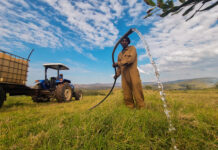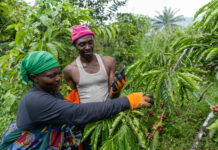A latest study by the National Institute for Communicable Diseases (NICD) has revealed critical insights into a foodborne disease outbreak that occurred at a restaurant in the City of Cape Town in February 2024.
The outbreak, which led to dozens of patrons and staff falling ill, was traced to Shigella spp./Enteroinvasive Escherichia coli (EIEC), highlighting the urgency for improved food safety measures in restaurants and fast food establishments across South Africa.
The investigation, published in the Public Health Bulletin South Africa, documented 46 suspected cases—34 patrons and 12 staff—who developed symptoms of acute gastroenteritis.
“This manuscript describes a foodborne disease outbreak that took place in the City of Cape Town, the investigation that occurred, and the public health response that was instituted to control the outbreak,” said Ms. Janine Bezuidenhoudt, Provincial Field Epidemiologist in the Western Cape Province and the National Institute for Communicable Diseases.
A Prompt Response Saves Lives
The alarm was raised on 8 February 2024, when a Cape Town general practitioner contacted the NICD after seeing multiple patients with similar symptoms, all of whom had eaten at the same restaurant the night before.
The rapid response triggered an investigation by the Western Cape Department of Health and Wellness and the City Health Environmental Health Practitioners (EHPs), initiating one of the few well-documented foodborne outbreak investigations in the country.
The surveillance and control measures followed the 7-1-7 target—an outbreak response benchmark calling for detection within seven days, notification within one day, and response initiation within seven days.
Bezuidenhoudt who is also the lead author of the study said that the public health actions instituted to control the outbreak met the 7-1-7 principle. “This demonstrates that effective coordination among health professionals, laboratories, and environmental teams can quickly stop transmission.”
The Outbreak: Scope and Findings
Stool and rectal swab samples were collected from 49 individuals. Thirty-three of those—six patrons and 27 staff—tested positive for Shigella spp./EIEC, a highly contagious pathogen spread through contaminated food, water, or by infected individuals.
Though no single food item was definitively identified as the outbreak’s source, environmental assessments flagged several hygiene breaches. “We found overstocked cold storage and violations of first-in, first-out food handling procedures,” the study noted. Food samples from the restaurant revealed high levels of coagulase-positive staphylococci and Bacillus cereus in mayonnaise and grilled items—indicating improper food storage and handling.
Most of the affected individuals exhibited symptoms such as diarrhoea (67%), abdominal cramps (63%), nausea (57%), and vomiting (50%). Of the 46 symptomatic individuals, 15 were hospitalised. Significantly, some staff members who were symptomatic continued to work, potentially exacerbating the spread of infection. “That’s a major food safety concern,” said Bezuidenhoudt.
Wider Public Health Implications
Foodborne diseases are a growing concern in South Africa. In 2024, a sharp rise in reported cases prompted the government to declare a national disaster. The World Health Organization estimates that globally, 600 million people fall ill and 420,000 die annually from contaminated food. Africa accounts for 137,000 of these deaths.
“Low- and middle-income countries are particularly vulnerable,” Bezuidenhoudt said. “Restaurants, tuck shops, and fast food establishments are increasingly implicated in these outbreaks. Unfortunately, most incidents go unreported or are not properly investigated.”
She added that this investigation stood out because of its comprehensiveness: “We had coordinated surveillance, laboratory testing, and environmental inspections. Most outbreaks in South Africa don’t get to that stage.”
A Call for Policy Change
Bezuidenhoudt and her colleagues are urging health authorities to adopt several policy changes based on the outbreak’s lessons. Chief among them is the development of national guidelines specifically for managing Shigella outbreaks. “We don’t currently have dedicated Shigella guidelines, which hampers response teams,” she noted.
In addition, she advocates for stricter food safety regulations, improved training for food handlers, and better coordination between the health department and environmental teams. “This outbreak reminds us that food handlers must stay home when sick and restaurants need to be proactive about hygiene,” she said.
The study also calls for increased public awareness. “People need to seek healthcare when they show symptoms of foodborne illness,” Bezuidenhoudt said. “Clinical samples are critical for identifying pathogens and ensuring appropriate public health responses.”
Lessons and Limitations
Although the response successfully contained the outbreak—no new cases were reported after the restaurant reopened on 19 February—several limitations were noted. A case-control study was not conducted, and complete food histories were not available for all cases. Also, molecular testing could not differentiate between Shigella spp. and EIEC, and no cultures or genome sequencing were performed, limiting source identification.
Despite this, the NICD considers the investigation a public health success and a model for future responses. “Our hope is that this article sparks further discussion on food safety and outbreak preparedness,” Bezuidenhoudt said.
Looking Ahead
The authors recommend that all restaurants regularly retrain staff on food safety and ensure compliance with hygiene laws. “We also urge the NICD and Department of Health to update national protocols and revise surveillance tools to better track and respond to foodborne outbreaks,” the report concludes.
As South Africa grapples with rising cases of food-related illness, the Cape Town incident offers both a cautionary tale and a hopeful example of what swift, coordinated public health action can achieve.








